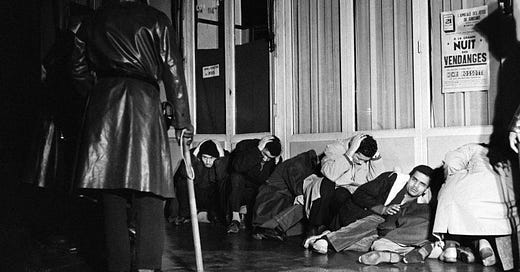The Bodies Beneath the Concrete: 'Murder in Memoriam' (Didier Daeninckx, 1984)
A review of Murder in Memoriam, by Didier Daeninckx (1984)
Paris, 1961: a demonstration by Parisian Algerians takes to the streets to protest the ongoing war. Though peaceful, the police react with extreme violence; killing hundreds and sending thousands more to prison. Watching the chaos unfold is Roger Thiraud, a history lecturer returning from the cinema to his pregnant wife. Though in no way connected to the protest, he is singled out by an officer and executed on the spot. In the final tally, his death is recorded as accidental.
20 years later in Toulouse, his son Bernard—also a historian—is returning from archival research. Whilst passing a dark alley he is watched, followed, and finally assassinated. Why he was killed and what connection this has to his father’s death falls on the desk of the sharp and daring Inspector Cadin. Weaving his way through a rapidly modernising country, Cadin finds more than just the father’s grave connected to Bernard’s death.
This is the setup of Murder in Memoriam. It’s a great premise, full of violence and mystery, and so I was a little thrown (though not unpleasantly) by how goofy Cadin often is. Such as, when he thinks an opportune time for some flirting with a witness is during a 1000 km road trip, the day after her fiancé was murdered:
“I’m stricken with an occupational disease very common among young cops, especially when they’re face to face with a witness as pretty as you’
[…]
The next words she said were in Saint-Cloud tunnel, five hundred and fifty kilometres later.
‘Where can I drop you.’ ”
Overall it’s a well executed detective plot. What made it feel so unique was how well it captured a particular time in history—not as a fixed place, but as a living moment when the embers of the past are beginning to fade and the future is so visibly emerging. Many of those who will hold high positions in this new world have pasts they’d rather were forgotten and are willing to go to extreme means to achieve it. This, paired with references to the Situationists; the conspicuous expansion of motorways, and growing mass media all combine to give texture to the setting without distracting from the story. Indeed, with its frugality of description and heavy reliance on dialogue, Murder in Memoriam could easily be read as a script for a play.
This capture of an era and exploration of the past turns what could have been just an engrossing and comical spy thriller into a mediation on history. It asks us to confront how our actions in the present will echo for decades to come, long after the situation we are responding to has passed. As Cadin digs deeper into the past, perpetrator and victim alike learn that no historical event is ever truly over, no matter how deeply the bodies are buried.
-Ben Shread-Hewitt
Other reviews of French Literature:
Depression Agronomics: ‘Serotonin’ (Michel Houellebecq, 2019)
A review of Serotonin, by Michel Houellebecq (2019)





